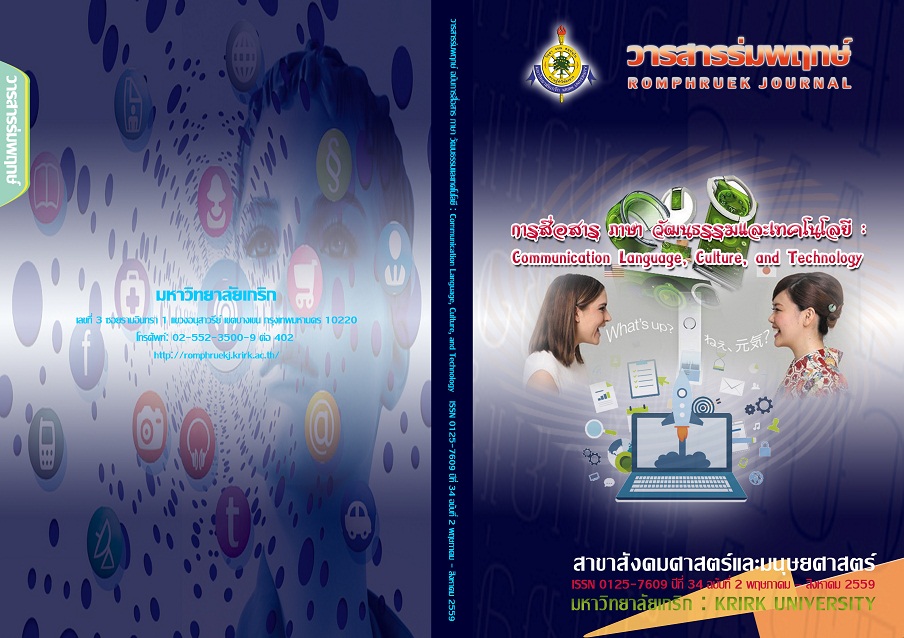Augmented Reality : เติมชีวิตให้สื่อสิ่งพิมพ์ทางการศึกษา ; Augmented Reality : Bringing Life to Educational Publications
Main Article Content
Abstract
Augmented Reality เป็นเทคโนโลยีที่น่าสนใจและมีการนำมาใช้อย่างหลากหลายด้วยความสามารถในการนำข้อมูลและเนื้อหาแบบดิจิทัลที่สร้างไว้มาซ้อนทับกับโลกความเป็นจริงได้อย่างกลมกลืนเสมือนเป็นการแสดงข้อมูลที่ถูกซ้อนเร้นอยู่ให้ปรากฏขึ้นตามที่ผู้สร้างต้องการ ทำให้การรับรู้ข้อมูลและเนื้อหาไม่ถูกจำกัดอยู่เพียงสิ่งที่มองเห็นอยู่ตรงหน้าอีกต่อไป และเมื่อนำ Augmented Reality มาประยุกต์ใช้กับการศึกษา โดยเฉพาะสื่อหลักของการเรียนการสอนคือ แบบเรียน ทำให้แบบเรียนซึ่งเป็นสิ่งพิมพ์ธรรมดากลายเป็นแบบเรียนนั้นน่าสนใจ ผู้เรียนได้รับประสบการณ์ที่ต่างไปจากเดิม สามารถนำความรู้นอกห้องเรียนมาสู่ในห้องเรียนได้ จูงใจผู้เรียนให้อยู่กับแบบเรียนที่ไม่ใช่เป็นเพียงแค่กระดาษที่มีไว้อ่าน แต่สามารถโต้ตอบและมีส่วนร่วมกับบทเรียนเสมือนเป็นบทเรียนที่มีชีวิต
Augmented reality is interesting and widely used due to its abilityto lay data and digital content over the physical world. Even hidden content could be seamlessly displayed to the users as required, freeing perception of data and content beyond the visible objects. Augmented reality could be used in education to supplement the textbooks which are the main media of teaching, turning them into interesting media. As a result, the learners could receive new experiences, bring external knowledge into the classroom, be enticed to study the rich content beyond mere paper, and interact with the lessons as if they were alive.
Article Details
Every article published in the Romphruek Journal of the Humanities and Social Sciences is the opinion and point of view of the authors. Thery're not the viewpoint of Krirk University or the editored department. Any part or all of the articles for pablication must be clearly cited.
References
ณัฐญา นาคะสันต์. (2553). การพัฒนารูปแบบการนำทางและลักษณะตัวนำทางสำหรับหนังสืออิเล็กทรอนิกส์
เพื่อการเรียนรู้ด้วยตนเอง. บัณฑิตวิทยาลัย มหาวิทยาลัยศรีนครินทรวิโรฒ.
นงลักษณ์ มีแก้ว และคณะ. (2557). Augmented Reality Technology (AR) เมื่อเทคโนโลยีสามารถเชื่อม
โลกเสมือนมาบรรจบกับโลกของความจริงและการประยุกต์ใช้ในการจัดการศึกษา. จุลสารนวัตกรรม,
(34), 8 - 16.
นวรัตน์ แซ่โค้ว. (2556). ความจริงเสมือนเพื่อการพัฒนาบทเรียนมัลติมีเดียปฏิสัมพันธ์แนะนำอุปกรณ์ คอมพิวเตอร์ในสถาบันอุดมศึกษาเอกชนขนาดใหญ่. วารสารวิจัยรามคำแหง, 16, 28 - 36.
มานพ สว่างจิต และ ไพฑูรย์ ศรีฟ้า. (2557). การพัฒนาความจริงเสมือ วิชาวิทยาศาสตร์ โรงเรียนที่มี
ผลสัมฤทธิ์ต่ำกว่าเกณฑ์มาตรฐาน สังกัดสำนักงานเขตพื้นที่การศึกษาประถมศึกษานครนายก.
วารสารเทคโนโลยีการศึกษาและมีเดียคอนเวอร์เจนซ์, 1, 87- 95.
สื่อเสริมการเรียนรู้โลกเสมือนผสมโลกจริง (Augmented Reality) เรื่องการจมและการลอย.
(8 ตุลาคม 2559) สืบค้นจาก http://secondsci.ipst.ac.th/index.php?option=com_
content&view=article&id=336:armedia&catid=19:2009-05-04-05-01-56&Itemid=34
Augmented Reality. (15 กรกฎาคม 2559) สืบค้นจาก http://rirs3.royin.go.th/coinages/webcoinage.php.
Augmented Reality. (15 กรกฎาคม 2559) สืบค้นจาก
http://www.merriam-webster.com/dictionary/augmented%20reality.
Augmented Reality เมื่อโลกเสมือนมาบรรจบกับความจริง. (9 ตุลาคม 2559) สืบค้นจาก
http://www.isriya.com/node/3109/augmented-reality.
Augmented Reality in Education and Training. (15 กรกฎาคม 2559) สืบค้นจาก
https://quality4digitallearning.org/wp-content/uploads/2016/03/ Augmented-Reality-
in-Education-and-Training.pdf.
Augmented Reality - Connecting Physical and Virtual Worlds. (8 กรกฎาคม 2559) สืบค้นจาก
http://www.slideshare.net/DunavNET/augmented-reality-47323934
Carmigniani, J, Furht B, editors. (2011). Handbook of Augmented Reality. New York : Springer.
Craig, A, B. (2013). Understanding Augmented Reality: Concept and Applications. Massachusetts : Elsevier.
How will people create content for augmented reality?. (12 กรกฎาคม 2559) สืบค้นจาก
http://www.pwc.com/us/en/technology-forecast/ augmented-reality/content-
creation.html.
Kipper, G. & Rampolla, J. (2013). Augmented Reality : An merging Technologies Guide to AR.
Massachusetts : Elsevier.
QR Code หลบไป AR มาแล้ว. (9 ตุลาคม 2559) สืบค้นจาก http://positioningmag.com/12795.

